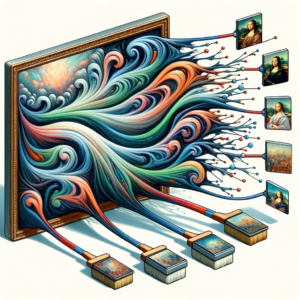There’s a simple answer to the question “what does AI stand for?” The term AI is an abbreviation for artificial intelligence. The definition for artificial intelligence is as follows: a field in computer science that refers to computers or machines being able to simulate human intelligence to perform tasks or solve problems. But those two letters “AI” represent more than just an abbreviation. AI stands for something that within our lifetimes will have altered our world more significantly and faster than any other technology since the discovery of electricity.
As we stand on the brink of a technological revolution, AI represents more than just an abbreviation. It’s a force poised to transform our world at an unprecedented pace. It’s time to explore, understand, and prepare for this inevitable wave of change, ensuring that we harness the power of AI for the betterment of humanity, rather than letting it take advantage of us.
In the 80s we learned that “knowing is half the battle” from the public service announcements brought to us by the characters in my favorite HASBRO cartoon G.I. Joe. The first step to ensuring that human intelligence reigns supreme is having a working understanding of artificial intelligence and its capabilities. For those who want to know and are seeking a beginner’s guide to artificial intelligence (AI) or an “AI for dummies” then keep reading.
What Does AI Stand For and What Are Its Capabilities?
While AI stands for artificial intelligence, at its core, it’s a term that encompasses various AI techniques and AI algorithms designed to simulate human intelligence processes. In this artificial intelligence definition, an algorithm is a step-by-step set of instructions that solves problems by completing specific tasks. AI researchers, using super sophisticated and complex algorithms, have given machines the ability to reason and learn on their own.
This type of AI research has already started to revolutionize sectors like healthcare, transportation, and finance. AI projects in the field of image recognition are transforming medical diagnostics. Similarly, AI solutions in the field of speech recognition (allowing computers to understand and convert spoken language into written text) are making smart devices, like smart speakers, more interactive. AI is even revolutionizing linguistics through natural language processing (NLP) by helping computers understand, interpret, and respond to human lagnuage in a way that’s meaningful. Rapid AI development in the past months and years has made it difficult to keep up all the benefits of artificial intelligence technology.
Artificial Intelligence Versus Machine Learning
Artificial intelligence refers to the broader field of creating machines that can perform tasks that typically require human intelligence, such as reasoning, problem solving, and natural language processing. Machine learning (ML) is a subset of both AI and computer science that focuses on using algorithms to learn from data to make predictions or decisions.
Machine learning often makes use of neural networks as a way of modeling complex patterns in data. A neural network is computer code that is modeled after the structure and function of the human mind and can be trained on large data sets to recognize patterns and make predictions. Machine learning is one aspect of AI, but not all AI systems use machine learning.
The Science of AI – Deep Learning Techniques

Photo: Image of a cat dataset used in deep learning, Jason Brownlee – Machine Learning Mastery
The breakthrough that put artificial intelligence on its current trajectory was a type of machine learning called “deep learning.” AI systems use tons of data points from a specific domain to recognize patterns and correlations linked to a desired outcome. If you feed AI algorithms using deep learning one million images labeled “cat” and one million images labeled “not cat,” they will be able to draw on its extensive network of correlations, many unseen or undetectable by a human being, to determine whether a new image is a cat or not.
This technique of using training data to fuel deep learning is what enables computer vision, a computer being able to look at an image and understand what’s in it. It also allows for speech recognition – a computer being able to understand human language – like when you talk to Siri on your iPhone.
By analyzing large amounts of data in a short period of time, the combination of deep learning algorithms and neural networks are providing computer systems the capabilities to make decisions like those a human brain might make, but at a much faster rate. This gives AI the potential to detect and predict diseases, revolutionize traffic conditions, and optimize stock selection. AI can also lead to greater accuracy and a reduction in the need for human intervention. This can improve processes and efficiency at all levels of almost every industry.
Narrow AI Versus Artificial General Intelligence
Narrow AI refers to AI models that are designed to perform a specific task or a set of tasks without possessing general problem-solving abilities. People sometimes refer to this kind of AI as “weak AI.” Examples of narrow AI include:
- Chatbots designed to simulate conversation with human users in a customer support situation. The banking and healthcare sectors use this type of AI to answer customer queries and provide information without the need for human intervention.
- Voice assistants like Siri, Alexa, and Google Assistant use AI to power their services. These virtual assistants use natural language processing to understand what we say and respond accordingly, and
- Recommendation systems used by Amazon, Netflix, or Spotify suggest movies, products, or music based on a user’s past behavior.
In contrast, Artificial General Intelligence (AGI), oftern referred to as strong AI or artificial super intelligence, aims to replicate human cognitive abilities, meaning it can understand, learn, and apply knowledge in various domains, much like a human. While narrow AI excels in specific domains like playing chess or image recognition, strong AI would have the versatility and adaptability of human intelligence across a wide range of tasks. The valid concerns of robots taking over the world are based on the development of AGI.
Generative AI: The Next Frontier in Artificial Intelligence

Photo: An illustration of a neural network generating a unique painting inspired by historical artworks. Auther generated by using the AI tool DALL-E 3.
Generative AI stands at the intersection of machine learning, deep learning, and neural networks. It represents a class of algorithms that can generate new data resembling the data it was trained on. One of the most notable examples of generative AI is the large language model (LLM), which can produce human-like text based on the patterns it has learned from vast amounts of textual data. Examples of large language models are ChatGPT and DALL-E by OpenAI, Bard by Google, or Claude by Anthropic. Unlike traditional machine learning models that predict outcomes based on input data, generative models can create entirely new data sets.
At the heart of generative AI lies deep neural networks that can process vast amounts of unstructured data, such as images, sound, and text, and learn intricate patterns within them. By doing so, they can produce new, synthetic instances of data that can be almost indistinguishable from real data.
Generative AI Means Something New
For instance, consider a generative model trained on a vast dataset of paintings. This model, using deep learning techniques, can generate a brand-new painting that, while entirely unique, captures the essence and style of the artworks it was trained on.
Generative AI also plays a pivotal role in predictive analytics. Predictive analytics is the use of data, statistical algorithms, and machine learning techniques to identify the likelihood of future outcomes based on historical data, aiming to forecast what might happen in the future. By simulating thousands of potential scenarios, these models can help businesses anticipate market trends, customer behaviors, and even potential risks. This predictive power, combined with the ability to generate new data, opens up a myriad of applications, from designing new products to creating realistic simulations for training purposes.
The Role of Data in AI
Data gathering, database management, and data science are crucial for AI’s success. Oftentimes the more data points an AI system has, the better its predictions. Data science, an interdisciplinary field, extracts knowledge and insights from structured data (think spreadsheets) and unstructured data (think social media posts, email messages, and medical records). Data scientists use their skills in mathematics, statistics, computer science, and domain knowledge to solve complex problems and make better decisions.
Advances in deep learning algorithms are allowing new data and better data – data that is accurate, relavant, and complete – to be more advantageous than more data. The use of machine learning, leveraging neural networks, enables AI to analyze new data, make sense of unstructured data and interpret big data to generate insights the human brain is incapble of making while reducing human error.
How We Are Already Using Autonomous AI Systems

Photo: Results of a survey on Artificial Intelligence of subscribers to “The Brief,” (January 20, 2023)
During my time in the House of Representatives when I hosted the first hearings in the history of Congress on artificial intelligence, it was easy to see how AI would transform the nature of work and affect every aspect of the economy. Right now, automated systems are replacing grocery store cashiers. We have AI assisted robotic surgery. Computer systems are using software written by AI. Factories are using robots that use AI technologies to work alongside humans. Millions of people are using virtual assistants and recomendation engines. Many folks remain unaware that AI tools already impact them in the following ways:
- Autonomous driving: Self driving cars use AI to understand and navigate the world around them. This includes tasks like recognizing traffic signs, pedestrians, and other vehicles.
- Medical imaging: Doctors are using AI and machine learning to analyze medical images, such as X-rays and CT scans, to detect and diagnose diseases.
- Drug development: Scientists have delployed AI to help identify and develop new medications, by analyzing vast quantities of data to identify potential drug targets.
- Fraud detection: Banks are using AI to detect fraudulent activity, such as credit card fraud or money laundering.
- How AI ATMS work: Financial institutions have embedded AI capabilities into bank ATMs to forecast demand more precisely and tell the banks when they must restock the ATMs so customers are always able to get cash out of the machine.
AI in the workplace will only continue to grow.
Asking AI Questions: The Dos and Don’ts

Photo: Screen capture of OpenAI CEO Sam Altman’s Twitter Feed (December 10, 2022)
A tool called ChatGPT is increasing the public’s consciousness of the power of AI. Developed by the San Francisco based company OpenAI, ChatGPT is a language model where GPT is short for “Generative Pre-training Transformer.” Engineers have tranied and fine-tuned ChatGPT to generate text that is similar to human-written language. The tool performs a variety of language generation tasks such as translation, question answering, and summarization.
In early 2023, the New York City Department of Education banned access to ChatGPT over fears “it could harm students’ education and in order to help prevent cheating. In an interview with StrictlyVC, OpenAI CEO Sam Altman sympathized with educators’ concerns and is already working on testing ways to curb plagiarism. However, he added, “Generative text is something we all need to adapt to. We adapted to calculators and changed what we tested for in math class. This is a more extreme version of that, no doubt, but also the benefits of it are more extreme, as well.”
Additionally, culture warriors and trolls are using ChatGPT as a platform to reinforce their own beliefs or criticize beliefs with which they disagree. Ultimately an AI system that uses machine learning and deep learning is trained on large datasets of conversations to be able to handle a wide variety of topics and viewpoints. While chatbots may sometimes reflect the biases of the data they are trained on, they are not inherently liberal or conservative, and can be manipulated to produce any kind of response intended by the user.
If you are asking AI questions, remember to use specific and concise language to increase the likelihood of getting a relevant response, and don’t expect the chatbot to be a substitute for human interaction. Understand its limitations and use it as a tool to speed up getting answers or assistance.
AI of the Future: Will it Change the Way We Live and Work?

Photo: Title shot of the Hanna-Barbera cartoon The Jetsons, originally aired in 1962 but took place 100 years in the future in 2062.
Many of the examples of artificial intelligence used in this article are examples of narrow AI — artificial intelligence systems designed for a specific task like recognizing faces in photographs, understanding language, or predicting outcomes in financial markets. However Artificial General Intelligence (AGI) is something different. AGI is a highly autonomous system that outperforms humans at most economically valuable work.
While we are far from a future portrayed in the cartoon The Jetsons, Intelligent machines that are powered by artificial general intelligence will wipe out a significant number of jobs — white collar, blue collar and no collar — up and down the economic ladder. In his brilliant book AI Super-Powers, Kai-Fu Lee explains that AI will impact various careers, including accountants, assembly line workers, warehouse operators, stock analysts, quality control inspectors, truckers, paralegals, and even radiologists.
This impact on the future of work will be accompanied by a significant concentration of wealth in the hands of a few AI tycoons.
The Benefits of Artificial Intelligence and How It Can Improve Our Lives
While its potential for taking over jobs is evident and concerning, Artificial General Intelligence will revolutionize many industries, create new kinds of jobs, and make life much easier for us humans in the long term. In 2017, PricewaterhouseCoopers estimated:
AI deployment could contribute up to $15.7 trillion to the global economy in 2030, more than the current output of China and India combined. Of this, $6.6 trillion is likely to come from increased productivity and $9.1 trillion is likely to come from consumption side effects.
What Artificial Intelligence Movies Get Right and Wrong

Talking about machine intelligence, machine learning, self-driving cars, computer vision, and speech recognition can seem like a page straight out of science fiction. Science fiction has long served a dual purpose, entertaining us with wild adventures and presenting thoughtful commentary on the ways in which our actions can shape and influence the future.
Sci-fi serves as a reminder to us that while technology changes constantly, we should also remain mindful of how this progress will impact humanity’s very identity as a species. Here are three sci fi movies often referenced when it comes to artificial intelligence:
- Matrix 3 (2003) – In this trilogy, the humans and the AI machines are in a tense standoff, with the humans trapped in the virtual reality of the Matrix while the machines harvest their energy. However, in the third film, a new threat emerges in the form of Agent Smith, compelling the humans and the machines to work together to stop him.
- I, Robot (2004) – This action movie, inspired by the Isaac Asimov short story collection of the same name, imagines a future in which robots are commonplace and a part of everyday life. However, when they start to exhibit dangerous behavior, the protagonist must figure out what is going on.
- Ex Machina (2014) – In this thriller, a scientist invites an employee to his secluded estate to participate in a test with a humanoid robot. The film explores the concept of artificial intelligence passing the “Turing Test” (the ability of a computer system to convincingly imitate human conversation).
Matrix 3 gets the potential for humans and AI working together to solve difficult challenges. I, Robot correctly predicts that robots will become more and more commonplace in our lives. Ex Machina accurately portrays the potential for artificial intelligence to pass the Turing Test and convincingly imitate human conversation.
One thing these movies all share is the level of AI advancement depicted as well beyond any realities of what we can currently achieve.
The Risks and Dangers Associated with Artificial Intelligence and How We Can Mitigate These Risks
The increasing sophistication and ubiquity of AI technology have sparked growing public concern over the rapid development of artificial intelligence and its potential impact on society. There is a growing need for legislators to consider how best to regulate this new field since AI technology poses several ethical concerns, including the potential for misuse by governments and corporations, and the need to protect the privacy of individuals.
Ethical AI: Navigating the Moral Landscape of Artificial Intelligence
As artificial intelligence continues to permeate every facet of our lives, the importance of ethical AI becomes paramount. Ethical AI refers to the practice of designing, developing, and deploying AI systems in a manner that prioritizes fairness, accountability, transparency, and the well-being of all stakeholders involved. Within this framework, responsible AI emphasizes the actionable steps and governance structures that ensure these ethical principles are effectively implemented in real-world scenarios.
Ethical AI and responsible AI seek to ensure that AI technologies are used for the greater good, avoiding biases, discrimination, and potential harm. Moreover, ethical AI emphasizes the need for clear guidelines and regulations to prevent misuse and unintended consequences. In a rapidly evolving digital age, ensuring that AI operates within a framework of moral and ethical standards is not just a technical challenge but a societal imperative.
TikTok Lawsuit Highlights How AI Is Potentially Going to Influence Our Lives
TikTok, a globally popular short-video sharing applications, is owned by ByteDance, a Chinese technology company. In 2021, Android phone users around the world spent 16.2 trillion minutes on TikTok. While those users probably had fun consuming silly videos, they also generated an enormous amount of data.
Data collection isn’t new, but TikTok’s usage raises questions. Where does the data go? Who accesses it? What does ByteDance do with it?
- In February 2019, TikTok faced a $5.7 million US Federal Trade Commission (FTC) fine. It was for collecting data from kids under 13 without parental consent.
- India banned TikTok in June 2020. Concerns were about data security and sovereignty. Indian officials claimed the app was “prejudicial to sovereignty and integrity of India.”
- In February 2021, ByteDance agreed to a $92 million settlement in a class action lawsuit. It was over alleged violatioins of state and federal privacy laws by collecting and using users’ biometric data without consent.
- In late 2022, TikTok confirmed to its European users that employees outside the continent, including in China, can access European data.
French President Emmanuel Macron has called TikTok “deceptively innocent” and a cause of “real addiction” among users. Additionally, he noted it as a source of Russian disinformation. U.S. Federal Communications Commission (FCC) commissioner Brendan Carr called TikTok “a sophisticated surveillance tool” and has worries that China could use sensitive and non-public data gleaned from the social media app for “blackmail, espionage, foreign influence campaigns and surveillance.”
The real danger of TikTok is that the Chinese government could use the massive amounts of data collected from TikTok users to train their machine learning and artificial intelligence algorithms that can spread dangerously effective propaganda about the failings of the United States and the greatness of China.
The former CEO of Twitter Jack Dorsey and its current CEO Elon Musk look positively nonpartisan next to Chinese President Xi Jinping. This is the battlefield of the 21st century. AI technology holds significant potential to manipulate and control individuals, posing a substantial threat to democracy. We’d do well to prepare ourselves now.
How We Can Prepare for the Future with AI?
Whenever new technologies seem likely to influence the cultural zeitgeist, folks always start making wild predictions. Some of the worst tech predictions in the past 100 years include:
- In 1876, the President of Western Union said, “This ‘telephone’ has far too many shortcomings to be taken seriously as a means of communication. It has objectively no value.”
- The President of the Michigan Savings Bank telling Henry Ford’s lawyer in 1903 that, “The automobile is a fad, a novelty. Horses are here to stay.”
- Film producer and 20th Century Fox movie executive, Darryl Zanuck stating in 1946 that, “Television will never hold onto an audience. People will very quickly get bored of staring at a plywood box every night”.
- In 1992, former Intel CEO Andy Grove made a comment about the idea of smartphones: “The idea of a personal communicator in every pockeet is nothing more than a pipe-dream fuelled by greed.”
Avoiding the Pitfalls of Historical Skepticism
We can’t let the kind of skepticisim we have seen historically prevent us from preparing our society for a future with AI. In the early 2000s nobody thought that 20 years later social media would lead to an increase in teenage girls cutting themselves or being the fuel to encourage insurrectionists to storm the Capitol. Our institutions – governments, academia, business, philanthropy — failed to address legitimate concerns about this technology in advance of it becoming a problem.
Ignoring, fighting, and failing to prepare for the coming inevitable ubiquity of artificial intelligence (AI) will make it harder for society to ensure we take advantage of this technology rather than it taking advantage of us.
We are already in the Age of Artificial Intelligence whether we recognize it or not. While discoveries in this field are going to continue, we are in a period of rapid adoption and use which means we need to be determining the ethical standards by which this implementation should evolve. Ethics seems like an old-timey word to be using with the latest cutting edge technology but doing what’s right according to a set of moral principles or values is what we need right now.
Four Things We Can Do Right Now
First, we need elected officials who are tech literate. We need legislators who use these technologies and are going to live in the future their policies are trying to shape.
Second, we need to codify into law who owns the fuel powering AI – data. Anything you do in your digital world is yours. You get to decide what happens with your data and who gets to use it. We have gone too long without codifying this principle into law.
Third, Congress should confirm that all AI tools must follow the law just like you and I do. There should be no special carve outs like social media got in its infancy from having to follow some of the same rules applied to newspapers and TV stations.
Fourth, instead of focusing on banning books and digital tools in the classroom, we need to teach our future generations the basics of this technology — coding and data science — as early as possible.
We can take advantage of this technology to uplift humanity rather than have this technology take advantage of us and create some dystopian future. We just can’t be dummies.
Note: Will Hurd is a former member of the board of directors for OpenAI.
First time reading? If you want rational takes on foreign policy, politics and technology then sign up below or click here for “The Brief.” It’s a twice-a-month email on things that aren’t being discussed but should – all in 5 minutes or less.






























